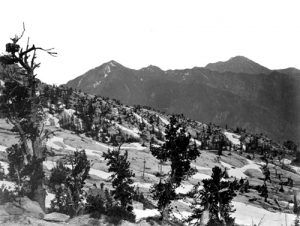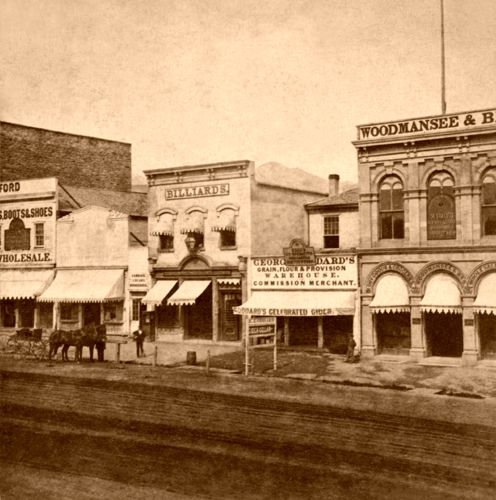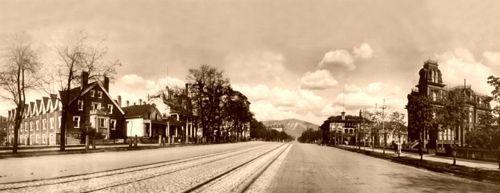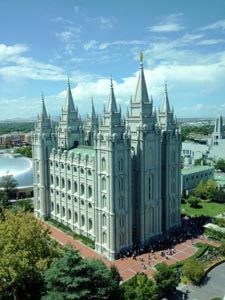By John Muir, 1918
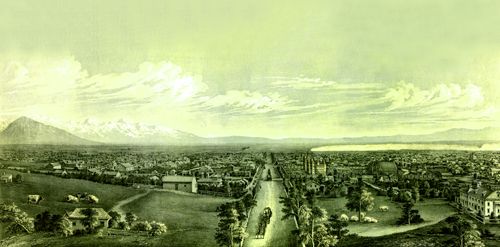
Salt Lake City, Utah
The mountains rise grandly around this curious city, the Zion of the new Saints, so grandly that the city itself is hardly visible. The Wahsatch Range, snow-laden and adorned with glacier-sculpted peaks, stretches continuously along the eastern horizon, forming the Great Salt Lake Basin boundary. At the same time, across the valley of the Jordan southwestward from here, you behold the Oquirrh Range, about as snowy and lofty as the Wahsatch. To the northwest, your eye skims the blue levels of the great lake, out of the midst of which rise island mountains, and beyond, at a distance of fifty miles, is seen the picturesque wall of the lakeside mountains blending with the lake and
the sky.
The glacial developments of these superb ranges are sharply sculptured peaks and crests, with ample wombs between them where the ancient snows of the glacial period were collected and transformed into ice. There are also ranks of profound shadowy canyons, while moraines commensurate with the lofty fountains extend into the valleys, forming far the grandest series of glacial monuments I have yet seen this side of the Sierra.
At The beginning of his letter, I meant to describe the city, but it is not easy to bend one’s attention to anything else in the company of these noble old mountains. Salt Lake cannot be called a very beautiful town; neither is there anything ugly or repulsive about it. From the slopes of the Wahsatch foothills or old lake benches toward Fort Douglas, it is seen to occupy the sloping gravelly delta of City Creek. This fine, hearty stream comes pouring through a majestic glacial canyon from the mountains’ snow. It is just where this stream comes forth into the light on the edge of the valley of the Jordan that the Mormons have built their new Jerusalem.
At first sight, the town’s external appearance is nothing very marked except its leafiness. Most of the houses are veiled with trees as if set down in the midst of one grand orchard; seen at a little distance, they appear like a field of glacier boulders overgrown with aspens, such as one often meets in the upper valleys of the California Sierra, for only the angular roofs are clearly visible.
Almost all of the houses are built of bluish-gray adobe bricks and are only one or two stories high, forming fine cottage homes that promise simple comfort within.
They are set well back from the street, leaving room for a flower garden, while almost everyone has a thrifty orchard at the sides and around the back. The gardens are laid out with great simplicity, indicating the love for flowers by people who are comparatively poor rather than the deliberate efforts of the rich for showy artistic effects. They are like the pet gardens of children, about as artless and humble, and harmonize with the low dwellings to which they belong. In almost everyone, you find daisies, mint, lilac bushes, and rows of plain English tulips. Lilacs and tulips are the most characteristic flowers, and nowhere have I seen them in greater perfection. As Oakland is pre-eminently a city of roses, so is this Mormon Saints’ Rest, which is a city of lilacs and tulips.
The flowers, at least, are saintly and surely loved. Scarce a home, however obscure, is without them, and the simple, unostentatious manner in which they are planted and gathered in pots and boxes about the windows shows how truly they are prized.
As soon as City Creek approaches its upper limit, its waters are drawn off right and left and distributed in brisk rills, one on each side of every street, the regular slopes of the delta upon which the city is built being admirably adapted to this system of street irrigation. These streams are all pure and sparkling in the upper streets, but as they are used to some extent as sewers, they soon manifest the consequence of contact with civilization. However, the speed of their flow prevents them from becoming offensive, and little Saints, not over particular, may be seen drinking from them everywhere.
The streets are remarkably wide and the buildings low, making them appear wider than they are. Trees are planted along the sidewalks–elms, poplars, maples, and a few catalpas and hawthorns; yet they are mostly small and irregular, and nowhere form avenues half so leafy and imposing as one would be led to expect. Even in the business streets, there is but little regularity in the buildings–now a row of plain adobe structures, half store, half dwelling, then a high mercantile block of red brick or sandstone, and again a row of adobe cottages nestled back among apple trees. There is one immense store with its sign up on the roof, in letters big enough to be read miles away, “Z.C.M.I.” (Zion’s Co-operative Mercantile Institution). At the same time, many a small, codfish corner grocery bears the legend “Holiness to the Lord, Z.C.M.I.” But little evidence will you find in this Zion, with its fifteen thousand souls, of great wealth, though many a Saint is seeking it as keenly as any Yankee Gentile. But on the other hand, searching throughout the city, you will not find any trace of squalor or extreme poverty.
Most of the women I have chanced to meet, especially those from the country, have a weary, repressed look as if, for the sake of their religion, they were patiently carrying burdens heavier than they were well able to bear. But, strange as it must seem to Gentiles, the many wives of one man, instead of being repelled from one another by jealousy, appear to be drawn all the closer together as if the real marriage existed between the wives only. Groups of half a dozen or so may frequently be seen on the streets in close conversation, looking as innocent and unspeculative as a lot of heifers, while the masculine Saints pass them by as if they belonged to a distinct species. In the Tabernacle last Sunday, one of the elders of the church, in discoursing upon the good things of life, the possessions of Latter-Day Saints, enumerated fruitful fields, horses, cows, wives, and implements, the wives being placed as above, between the cows and implements, without receiving any superior emphasis.
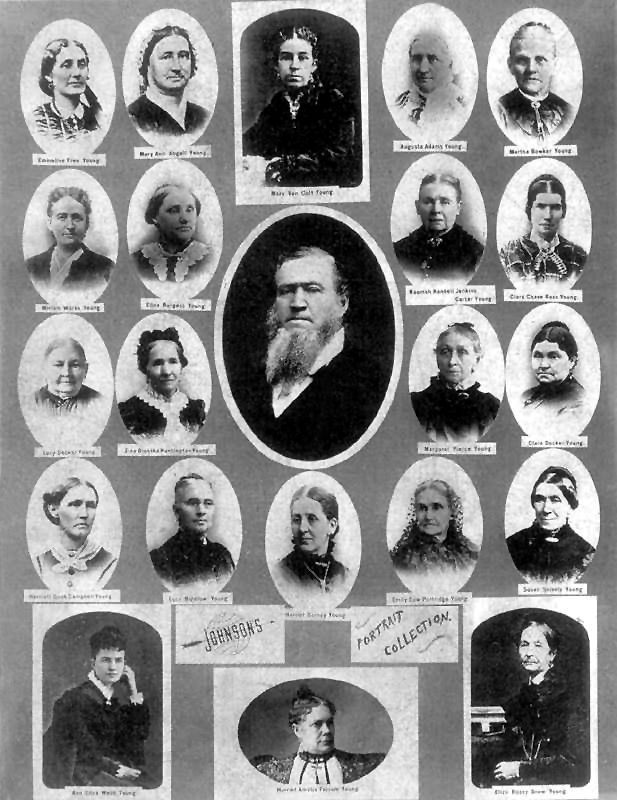
Brigham Young was an ardent supporter of polygamy, marrying 56 wives during his lifetime and fathering 57 children. This photo shows less than half of his wives.
Polygamy, as far as I have observed, exerts a more degrading influence upon husbands than upon wives. The latter’s love finds expression in flowers and children, while the former seems to be rendered incapable of pure love of anything. The spirit of Mormonism is intensely exclusive and un-American. A more withdrawn, compact, sealed-up body of people could hardly be found on the face of the earth than is gathered here, notwithstanding railroads, telegraphs, and the penetrating lights that go sifting through society everywhere in this revolutionary, question-asking century.
Most of the Mormons I have met seem to be in a state of perpetual apology, which can hardly be fully accounted for by Gentile attacks. At any rate, it is unspeakably offensive to any free man.
“We Saints,” they continually say, “are not as bad as we are called. We don’t murder those who differ with us but rather treat them with all charity. You may go through our town night or day, and no harm shall befall you. Go into our houses, and you will be well used. We are as glad as you are that Lee was punished,” etc.
While taking a saunter the other evening, we were overtaken by a characteristic Mormon, “a humble man,” who made us a very deferential salute and then walked on with us about half a mile. We discussed whatever Mormon doctrines came to mind with American freedom, which he defended as best he could, speaking in an excited but deprecating tone.
When hard pressed, he would say, “I don’t understand these deep things, but the elders do. I’m only a humble tradesman.” In taking leave, he thanked us for the pleasure of our querulous conversation, removed his hat, aowed lowly in a sort of Uriah Heep manner, and then went to his humble home. We did not learn how many humble wives it contained.
Fine specimens of manhood are by no means wanting, but the number of people one meets here who have some physical defect or who attract one’s attention by some mental peculiarity that manifests itself through the eyes is astonishingly great in so small a city. It would evidently be unfair to attribute these defects to Mormonism. However, Mormonism has undoubtedly been the magnet that elected and drew these strange people together from all parts of the world.
But however, “the peculiar doctrines” and “peculiar practices” of Mormonism have affected the bodies and the minds of the old Saints; the little Latter-Day boys and girls are as happy and natural as possible, running wild, with plenty of good hearty parental indulgence, playing, fighting, gathering flowers in delightful innocence; and when we consider that most of the parents have been drawn from the thickly settled portion of the Old World, where they have long suffered the repression of hunger and hard toil, the Mormon children, “Utah’s best crop,” seem remarkably bright and promising.
From children, one passes naturally into the blooming wilderness to the pure religion of sunshine and snow, where all the good and the evil of these strange people lift and vanish from the mind like mist from the mountains.
By John Muir, 1918 (published after his death). Compiled and edited by Kathy Weiser/Legends of America, updated April 2024. The text is not verbatim, as grammatical errors and spelling have been corrected, and the text has been updated for the modern reader.
Also See:
Mormon Handcart Tragedy of 1856
Brigham Young – Leading the Mormons
Joseph Smith – Founder of the Mormon Church
Grafton, Utah – Virgin River Ghost Town
About the Author: Written by John Muir, The City of Saints is Chapter 6 of Muir’s 1918 book Steep Trails, published after his death. Muir worked on several vacations during his lifetime, including farming, inventory, and ranching, but he was most happy as a naturalist, explorer, and conservationist. Widely traveled, especially in the American West, he actively wrote about his adventures, nature, and wildlife in his many letters, essays, articles, and books. After years of wanderlust, Muir died of pneumonia in Los Angeles, California, in January 1914.

